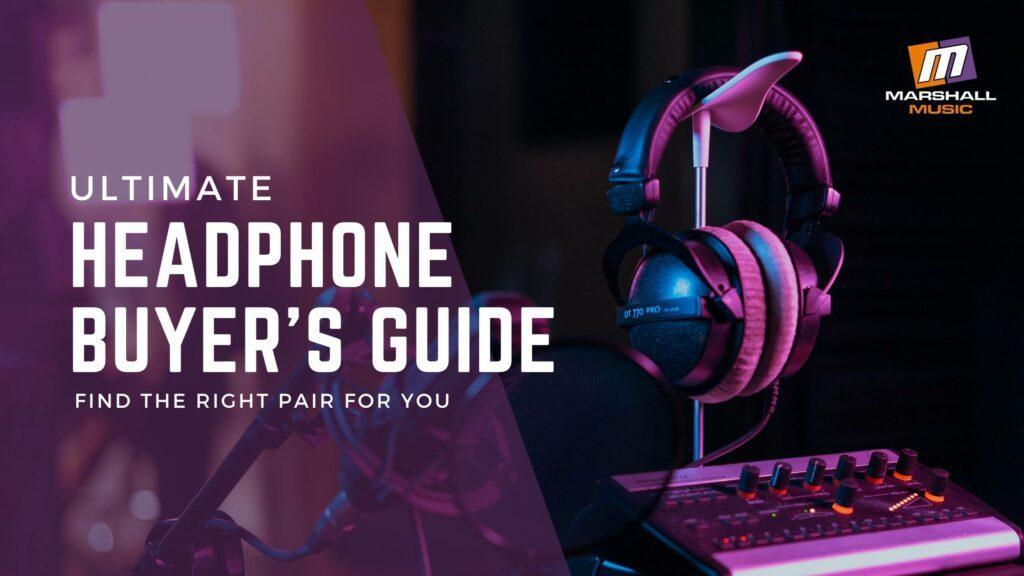How to Choose the Right Headphones for the Job
It’s a question we hear every day: “What’s the best pair of headphones I can get for ___?” That’s a tricky question. If you just look at baseline professional-quality studio headphones, you’ll see that there are about a half a dozen or more models, all at similar prices. Their specs are even similar! Your Marshall Music Sales Engineer has the training and knowledge to help guide you to the best choice for your situation and budget.
Start with Your Application
Don’t start with the headphones; start with the application you need headphones for. If you’re tracking in the studio, you’re going have different needs than if you want to monitor and tweak a live headphone mix. If you’re playing drums on a recording, your needs will be totally different than if you’re singing in a well designed vocal booth. In the following sections, we’ll cover some of the important considerations you can use to figure out what the right headphones are for the job at hand. We’ll also cover some common pitfalls so you’re prepared to avoid them.
Headphone Terminology
Circumaural vs. Supra-aural
In layman’s terms, these terms simply mean “around the ear” (circumaural) and “above the ear” (supra-aural). In the case of headphones, this refers to the design of the earcup, which is the cushion that sits between the headphone’s speakers (drivers) and your ear. You’re not going to find many professional-quality supra-aural headphones.

Closed-back vs. Open-back
Also referred to sometimes as simply “closed” and “open,” this distinction addresses the design of the part of the headphone that covers the area behind the driver in a straight line away from the side of your head. Closed headphones prevent sound from escaping. The downside of this design is that it traps pressure inside the headphone, which creates false low frequencies. These false low frequencies are fine for most professional uses (and even desirable in consumer products), but less desirable for critical listening.

For critical listening, headphones with an open back often provide a more accurate frequency balance, with the trade off of providing slightly less isolation. Extremely well engineered open-back headphones provide almost the same isolation as high quality closed back headphones, but its a luxury you’ll have to pay for. That said, there are some excellent “semi-open-back” headphones that are affordable, well balanced, and provide enough isolation for some professional tracking applications.
Recording in the Studio
It almost goes without saying that isolation is one of the general key characteristics to look for in tracking headphones. Outfitting your studio with enough pro-quality headphones isn’t cheap, but you don’t have to provide top-dollar headphones for everyone. Rather than pick up several of the same model, however, you may want to diversify by application.
Drums: Acoustic isolation matters more than anything for tracking drums. Not only is this isolation necessary for blocking out the sound of the drums (thereby allowing the drummer to hear the mix), but it keeps the click and reference mix from bleeding out into the microphones. We recommend 25-29dB of sound isolation minimum for tracking drums. Second to isolation is low-frequency reproduction. Fortunately, the kind of tightly sealed closed-back headphones that provide the isolation you need also have a slightly disproportionate low end.
Electric Guitar and Bass: Depending on how you track these, you can use standard closed-back headphones, semi-open-back headphones, or no headphones at all. You’ll probably need to considerably turn up the monitor mix if the guitarist or bassist is tracking with the amp in the same room, just to allow them to hear the mix. Although it’s not likely that semi-open-back headphones will audibly bleed into the mic, you may want to use closed-back headphones just for their isolation.
Acoustic Guitar (and Other Instruments): This one’s simple – play it safe. You’re better off using closed-back headphones with proper isolation than realizing too late that there’s headphone bleed in the tracks you recorded.
Vocals: Vocalists rely both on proper pitches and frequency balance to sing correctly. To a singer, this is the difference between a good feeling and a murky one when you sing. To an engineer, this can be the difference between a lively performance and one that’s flat both in energy and in pitch. Ideally, you’d use high-end open-back headphones for tracking vocals. If you have the money for one great pair of headphones and several pairs of baseline pro-quality sets, or you’re a vocalist who wants to have a great set of ‘phones for recording, then this is one investment you want to make.
If you don’t have the cash for a set of high-end headphones, you can try using a less expensive semi-open-back model. However, you still want to avoid sound bleeding from the headphones into the mic. If you can’t find a headphone level that’s quiet enough to prevent all but a minimal/acceptable level of bleed, you’ll need to switch over to closed-back headphones.
Mixing and Monitoring
During tracking, a good pair of reference quality headphones (almost always high-end open-back headphones) can help you identify problems (such as ground hum and the buzzing of bad cables) that you don’t want to be stuck with later. During mixing, headphones let you hone in on details in the tracks you’ve recorded to isolate similar problems.
Headphones also act as a great way to hear your mix without hearing the impact of your room. Simply put, the headphones you use in your control room/mixing suite should have the clearest and most accurate frequency response possible (just like your studio monitors). We recommend open-back or semi-open-back headphones for these applications.
One last note: Remember that this is the iPod age. You’ll want to keep a pair of regular, single-driver earphones (a.k.a. ear buds) on hand when you mix. These will let you hear what your final mix will sound like to the majority of listeners.
Live Sound Applications
The most important characteristics for live headphones is their ability to seal out the overwhelming sound level in the house so that you can hear what’s going on in your own mix.
Onstage: When it comes to live headphones, in-ear monitors (also called earphones) are by far the most popular format. Professional in-ear monitors are extremely low profile and fit more-or-less like ear plugs. They’re nearly invisible from more than a few feet away, and they block out sound so well that most bands who use them actually benefit from a microphone or two used to pick up some crowd noise for reference.
Due to the size and design of standard single-driver earphones, they tend to have extremely limited low-end expression. This limited low end is a deal-breaker for pretty much any bass player or drummer. Bass players and drummers don’t just need to hear low frequencies, they need to feel them. To accommodate low-frequency instruments, there are excellent multi-driver earphones out there that act like 2- or 3-way PA speakers, with dedicated drivers for higher and lower frequency ranges. These earphone pack serious punch, meeting the expectations of bassists and drummers, but they aren’t cheap.
At the Board: You’ll want to keep a pair of closed-back headphones at the board for soloing and troubleshooting. The typical sound pressure level at the mix position is about 110dB (i.e. really loud), so you’ll need headphones with heroic isolation if you want to hear clearly. Also, if you mix bands that play with in-ear monitors, be sure to have a pair of your own in-ears back at the board, preferably the same kind, but stick with a single-driver model. That way you can set up in-ear mixes and hear more-or-less exactly what the band hears.
What to Look For
Hopefully this buying guide presented some insight into headphones and provided some ideas for what you should be looking for.
Choose headphones based on your application(s)
What you need headphones for will dictate what kind of headphones you should be looking for.
Types of headphones
Headphones come in two basic styles: closed-back or open-back. Closed-back phones give you better isolation, but this isolation usually comes with a slight bass boost. Open-back ‘phones offer more natural sound, but the tradeoff is isolation.
Headphones in the studio
You’ll likely need multiple sets of standard studio headphones for general tracking, along with specialty headphones for specific applications. Vocalists present a special challenge, as they need a blend of isolation and accuracy. Reference-quality headphones are also good for identifying problems such as hum and buzz in your tracks.
Headphones in live sound
Good isolation headphones are awesome for checking your mixes at the monitor mixing station or the FOH position. Onstage, in-ear monitors give performers a clear picture of what they and their fellow performers are doing.

